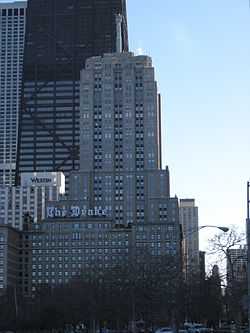Palmolive Building
|
Palmolive Building | |
|
Chicago Landmark | |
 | |
|
The Palmolive Building | |
 | |
| Location | 919 N Michigan Avenue, Chicago, IL 60611, USA |
|---|---|
| Coordinates | 41°53′59.41″N 87°37′25.94″W / 41.8998361°N 87.6238722°WCoordinates: 41°53′59.41″N 87°37′25.94″W / 41.8998361°N 87.6238722°W |
| Built | 1929 |
| Architect | Holabird & Root |
| Architectural style | Art Deco |
| Governing body | Private |
| NRHP Reference # | 03000784 [1] |
| Significant dates | |
| Added to NRHP | August 21, 2003 |
| Designated CL | February 16, 2000 |

The Palmolive Building, formerly the Playboy Building, is a 37-story Art Deco building at 919 N. Michigan Avenue in Chicago. Built by Holabird & Root, it was completed in 1929 and was home to the Colgate-Palmolive-Peet corporation.
The Palmolive Building came to be known as the Playboy Building from 1965 to 1989, when it was home to Playboy magazine.[2] During this time, the word P-L-A-Y-B-O-Y was spelled out in 9 feet (2.7 m) illuminated letters.[3] It was designated a Chicago Landmark in 2000,[2] and it was added to the federal National Register of Historic Places in 2003.
Today, the building has been converted for residential use by developer Draper and Kramer. The first two floors house upscale office and retail space. High-end condos make up the rest of the building. Notable residents of the building include Vince Vaughn and Lou Piniella.[citation needed]
Lindbergh Beacon
A beacon named for the aviator Charles Lindbergh was added to the building in 1930. The Beacon was renamed the Palmolive after Lindbergh's support of Nazi Germany.[4] It rotated a full 360 degrees and was intended to help guide airplanes safely to Midway Airport.[5] The beacon beamed for several decades, and ceased operation in 1981 following complaints from residents of nearby buildings.[5] During the Palmolive Building's conversion to condominiums in the late 2000s, the beacon was modified to rotate back and forth, always pointing at the lake, so as to avoid shining light into other buildings. Subsequently, the historic beacon resumed operation.
References
- ↑ "National Register Information System". National Register of Historic Places. National Park Service. 2007-01-23.
- ↑ 2.0 2.1 "Palmolive Building". City of Chicago Dept. of Pl. and Devpmt., Landmarks Div. 2003. Retrieved 2007-05-21.
- ↑ "Palmolive Building". Emporis. 2007. Retrieved 2007-05-21.
- ↑ Bill Bryson
- ↑ 5.0 5.1 Cheryl Burton (July 5, 2007). "Palmolive Beacon lights up the lake again". ABC 7 News. Retrieved 2010-01-10.
See also
![]() Media related to Palmolive Building at Wikimedia Commons
Media related to Palmolive Building at Wikimedia Commons
- Chicago architecture
- List of tallest buildings in Chicago
| ||||||||||||||||||||
| |||||||||||||||||